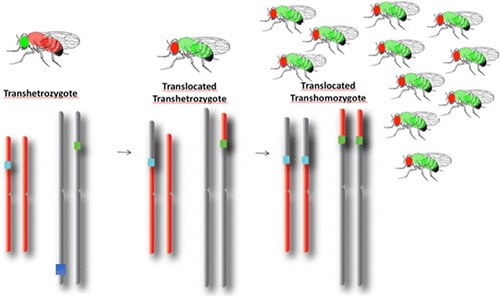当前位置:
X-MOL 学术
›
ACS Synth. Biol.
›
论文详情
Our official English website, www.x-mol.net, welcomes your
feedback! (Note: you will need to create a separate account there.)
Engineered Reciprocal Chromosome Translocations Drive High Threshold, Reversible Population Replacement in Drosophila
ACS Synthetic Biology ( IF 3.7 ) Pub Date : 2018-04-02 00:00:00 , DOI: 10.1021/acssynbio.7b00451 Anna B Buchman 1, 2 , Tobin Ivy 1 , John M Marshall 3 , Omar S Akbari 1, 2 , Bruce A Hay 1, 2
ACS Synthetic Biology ( IF 3.7 ) Pub Date : 2018-04-02 00:00:00 , DOI: 10.1021/acssynbio.7b00451 Anna B Buchman 1, 2 , Tobin Ivy 1 , John M Marshall 3 , Omar S Akbari 1, 2 , Bruce A Hay 1, 2
Affiliation

|
Replacement of wild insect populations with transgene-bearing individuals unable to transmit disease or survive under specific environmental conditions using gene drive provides a self-perpetuating method of disease prevention. Mechanisms that require the gene drive element and linked cargo to exceed a high threshold frequency in order for spread to occur are attractive because they offer several points of control: they bring about local, but not global population replacement; and transgenes can be eliminated by reintroducing wildtypes into the population so as to drive the frequency of transgenes below the threshold frequency required for drive. Reciprocal chromosome translocations were proposed as a tool for bringing about high threshold population replacement in 1940 and 1968. However, translocations able to achieve this goal have only been reported once, in the spider mite Tetranychus urticae, a haplo-diploid species in which there is strong selection in haploid males for fit homozygotes. We report the creation of engineered translocation-bearing strains of Drosophila melanogaster, generated through targeted chromosomal breakage and homologous recombination. These strains drive high threshold population replacement in laboratory populations. While it remains to be shown that engineered translocations can bring about population replacement in wild populations, these observations suggest that further exploration of engineered translocations as a tool for controlled population replacement is warranted.
中文翻译:

工程染色体相互易位驱动果蝇的高阈值、可逆群体更替
用无法传播疾病或使用基因驱动在特定环境条件下生存的转基因个体取代野生昆虫种群,提供了一种自我延续的疾病预防方法。需要基因驱动元件和相关货物超过高阈值频率才能发生传播的机制很有吸引力,因为它们提供了几个控制点:它们带来局部而非全球人口替代;可以通过将野生型重新引入群体来消除转基因,从而使转基因频率低于驱动所需的阈值频率。1940年和1968年,染色体相互易位被提出作为实现高阈值种群更替的工具。然而,能够实现这一目标的易位仅在叶螨Tetranychus urticae中被报道过一次,这是一种单倍体二倍体物种,其中有在单倍体雄性中对适合的纯合子进行强有力的选择。我们报告了通过定向染色体断裂和同源重组产生的工程易位携带菌株的果蝇的创建。这些菌株推动了实验室群体的高阈值群体替代。虽然工程易位能否带来野生种群的种群置换仍有待证明,但这些观察结果表明,有必要进一步探索工程易位作为控制种群置换的工具。
更新日期:2018-04-02
中文翻译:

工程染色体相互易位驱动果蝇的高阈值、可逆群体更替
用无法传播疾病或使用基因驱动在特定环境条件下生存的转基因个体取代野生昆虫种群,提供了一种自我延续的疾病预防方法。需要基因驱动元件和相关货物超过高阈值频率才能发生传播的机制很有吸引力,因为它们提供了几个控制点:它们带来局部而非全球人口替代;可以通过将野生型重新引入群体来消除转基因,从而使转基因频率低于驱动所需的阈值频率。1940年和1968年,染色体相互易位被提出作为实现高阈值种群更替的工具。然而,能够实现这一目标的易位仅在叶螨Tetranychus urticae中被报道过一次,这是一种单倍体二倍体物种,其中有在单倍体雄性中对适合的纯合子进行强有力的选择。我们报告了通过定向染色体断裂和同源重组产生的工程易位携带菌株的果蝇的创建。这些菌株推动了实验室群体的高阈值群体替代。虽然工程易位能否带来野生种群的种群置换仍有待证明,但这些观察结果表明,有必要进一步探索工程易位作为控制种群置换的工具。











































 京公网安备 11010802027423号
京公网安备 11010802027423号